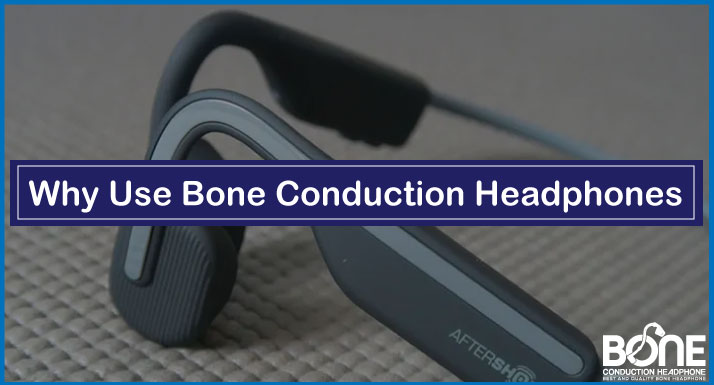Are bone conduction headphones good for you? There is a new technology in the market, the bone conduction headphones, and they’re making some noise, and mind you, that noise is primarily due to the positive impact the technology is having on its customers. Is it time you got one, or are you confused about the ambiguity: Why Use Bone Conduction Headphones? Well, there are numerous reasons and benefits they bring. Do you want to know? Let’s find out.
The questions concerning people who don’t know much about bone conduction headphones are: should they use these headphones or not? Are they worth it? Can they be harmful?
We came up with this detailed article giving you reasons as to why you should use these headphones.
Why Use Bone Conduction Headphones?

My long experience with these headsets has given me firsthand insight into the numerous benefits of bone conduction headphones. From starting from comfort, usability, and trend, you can ignore the convenience these headsets bring.
Perfect Fit
Are bone conduction headphones comfortable? I have been using Shokz OpenRun Pro, and the headband’s open ear comfort and proper clamping force help my running routine. So, yes, they are comfortable and a perfect fit.
Unlike the usual or traditional headphones, your ears would not feel sore after you use the bone conduction headphones. These headphones are a perfect fit against your face, keeping you at ease while you’re free to do any movement.
Use Bone Conduction as Hearing Aid

The critical benefit of bone conduction headphones is that you can use them as hearing aid. The main reason for the invention of bone conduction headphones was to make things smoother for people with hearing loss.
If you have hearing issues and can’t enjoy your music in stereo, you don’t have to worry anymore; the bone conduction headphones are here. It bypasses the outer and middle ears, so it transfers sound directly to the cochlea and is therefore suitable for both conductive and mixed hearing loss.
You’re Aware Of The Environment

People often discuss the concern that: Are bone conduction headphones safer? When I go cycling, I always wear my bone conduction headsets. They keep me aware of the surrounding situation, like vehicles and pedestrians.
In a word, there’s no doubt that you enjoy your music during your walks or workouts with traditional headphones, but you can easily get distracted, which leaves you exposed to vulnerabilities. The bone conduction headphones ensure you’re aware of things happening around you.
Unique Design
The traditional headphones can look too normal or mainstream at times. All are going right into your ears; it’s the same design. Bone conduction headphones Bluetooth wireless headset has a unique design and can be attractive and stylish, making people notice them.
Waterproofing
Another reason for using bone conduction headphones is that they’re waterproof, obviously, to some extent. I use my Tayogo IPX8 8GB Waterproof for my swimming routine. Although, to some extent, enables you to go fishing or scuba diving while you have these headphones on, this is undoubtedly an excellent feature, if not the coolest.
Less Cleaning
Since the bone conduction headphones are meant to go above the cheekbones, delivering the vibrations straight into your ears, they don’t get so messy, or they don’t get messy at all. You don’t have to stress over wasting your time cleaning them every alternate day.
Can a deaf person hear with bone conduction?

When I gave bone conduction headphones to Deaf people instead of hearing aids to listen to music and watch videos, I found out that Aftershokz Trekz Titanium was helpful. These headsets were initially designed for people who run because their ears are left open when running. Children who are deaf can also benefit from bone conduction headphones since they can hear sounds around them, including traffic.
Frequently Asked Questions (FAQs)
How To Use Bone Conduction Headphones In a Safe Manner?
The safest way of using these headphones is to make sure that the volume of these headphones is decent. The volume shouldn’t be too high since that can expose you to the risk of hearing loss and other ear troubles. The best volume recommended for these headphones is 60 percent; try not to go above that.
Do Bone Conduction Headphones Work With Earplugs?
Bone conduction headphones transfer vibrations from the cheekbones to the inner ear, where the cochlea is located. As a result, bone conduction headphones work by transmitting sound signals directly to your brain. Bone conduction headphones do not cover the ears that leave the ears open, which enables you to wear earplugs with bone conduction.
Who Should Wear Bone Conduction Headphones?
The bone conduction headphones are most suitable for people who suffer from hearing loss, even if it’s a partial hearing loss. People with no hearing issues can also use them, but traditional headphones are probably a better option.
Conclusion
So, Are bone conduction headphones worth it? In conclusion, bone conduction headphones may provide some benefits but may not be as great as you think. Still, they all make things and life easier for their users if you choose from the best bone conduction headphones.
They can be a great help for people struggling with hearing loss or partial hearing loss. These benefits can also go unnoticed quickly, but the bone conduction headphones would seem like a good deal if you pay attention to details.

